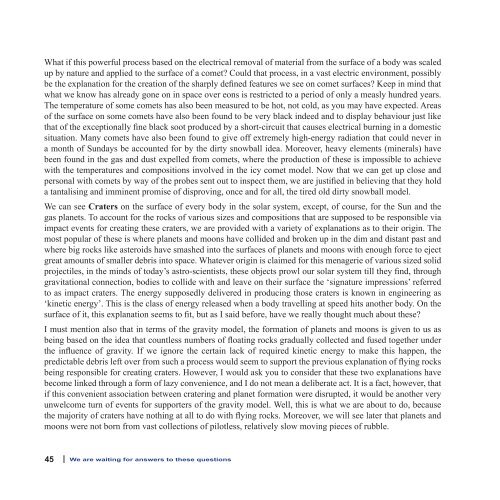A Beginner's View of Our Electric Universe - New
A Beginner's View of Our Electric Universe - New
A Beginner's View of Our Electric Universe - New
Create successful ePaper yourself
Turn your PDF publications into a flip-book with our unique Google optimized e-Paper software.
What if this powerful process based on the electrical removal <strong>of</strong> material from the surface <strong>of</strong> a body was scaled<br />
up by nature and applied to the surface <strong>of</strong> a comet? Could that process, in a vast electric environment, possibly<br />
be the explanation for the creation <strong>of</strong> the sharply defined features we see on comet surfaces? Keep in mind that<br />
what we know has already gone on in space over eons is restricted to a period <strong>of</strong> only a measly hundred years.<br />
The temperature <strong>of</strong> some comets has also been measured to be hot, not cold, as you may have expected. Areas<br />
<strong>of</strong> the surface on some comets have also been found to be very black indeed and to display behaviour just like<br />
that <strong>of</strong> the exceptionally fine black soot produced by a short-circuit that causes electrical burning in a domestic<br />
situation. Many comets have also been found to give <strong>of</strong>f extremely high-energy radiation that could never in<br />
a month <strong>of</strong> Sundays be accounted for by the dirty snowball idea. Moreover, heavy elements (minerals) have<br />
been found in the gas and dust expelled from comets, where the production <strong>of</strong> these is impossible to achieve<br />
with the temperatures and compositions involved in the icy comet model. Now that we can get up close and<br />
personal with comets by way <strong>of</strong> the probes sent out to inspect them, we are justified in believing that they hold<br />
a tantalising and imminent promise <strong>of</strong> disproving, once and for all, the tired old dirty snowball model.<br />
We can see Craters on the surface <strong>of</strong> every body in the solar system, except, <strong>of</strong> course, for the Sun and the<br />
gas planets. To account for the rocks <strong>of</strong> various sizes and compositions that are supposed to be responsible via<br />
impact events for creating these craters, we are provided with a variety <strong>of</strong> explanations as to their origin. The<br />
most popular <strong>of</strong> these is where planets and moons have collided and broken up in the dim and distant past and<br />
where big rocks like asteroids have smashed into the surfaces <strong>of</strong> planets and moons with enough force to eject<br />
great amounts <strong>of</strong> smaller debris into space. Whatever origin is claimed for this menagerie <strong>of</strong> various sized solid<br />
projectiles, in the minds <strong>of</strong> today’s astro-scientists, these objects prowl our solar system till they find, through<br />
gravitational connection, bodies to collide with and leave on their surface the ‘signature impressions’ referred<br />
to as impact craters. The energy supposedly delivered in producing those craters is known in engineering as<br />
‘kinetic energy’. This is the class <strong>of</strong> energy released when a body travelling at speed hits another body. On the<br />
surface <strong>of</strong> it, this explanation seems to fit, but as I said before, have we really thought much about these?<br />
I must mention also that in terms <strong>of</strong> the gravity model, the formation <strong>of</strong> planets and moons is given to us as<br />
being based on the idea that countless numbers <strong>of</strong> floating rocks gradually collected and fused together under<br />
the influence <strong>of</strong> gravity. If we ignore the certain lack <strong>of</strong> required kinetic energy to make this happen, the<br />
predictable debris left over from such a process would seem to support the previous explanation <strong>of</strong> flying rocks<br />
being responsible for creating craters. However, I would ask you to consider that these two explanations have<br />
become linked through a form <strong>of</strong> lazy convenience, and I do not mean a deliberate act. It is a fact, however, that<br />
if this convenient association between cratering and planet formation were disrupted, it would be another very<br />
unwelcome turn <strong>of</strong> events for supporters <strong>of</strong> the gravity model. Well, this is what we are about to do, because<br />
the majority <strong>of</strong> craters have nothing at all to do with flying rocks. Moreover, we will see later that planets and<br />
moons were not born from vast collections <strong>of</strong> pilotless, relatively slow moving pieces <strong>of</strong> rubble.<br />
45 | We are waiting for answers to these questions


